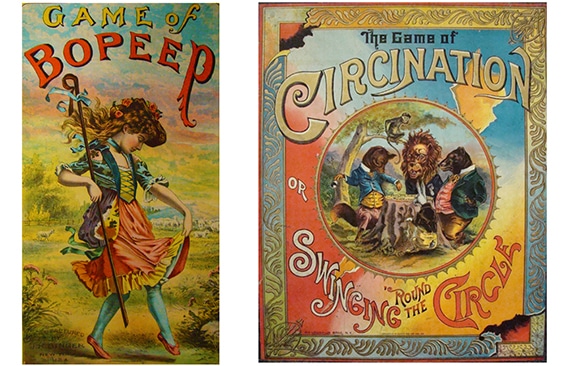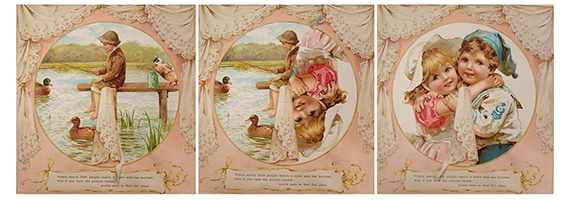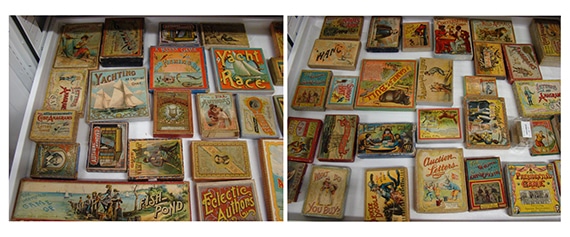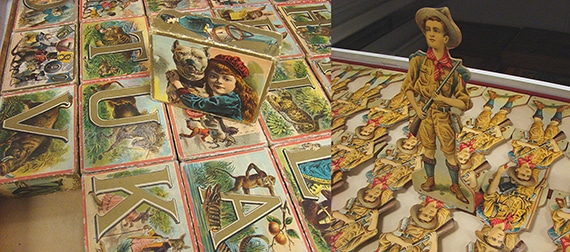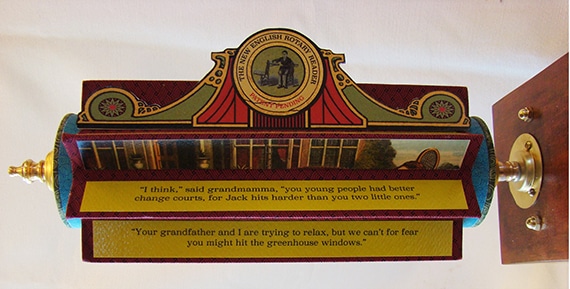My love of movable books and of antique toys and games containing the richly colored chromolithographs of the last half of the 1800s brought me to The Strong’s Online Collections. I spent four days “oohing” and “ahhing” over the vast archive of images in the museum’s database before I discovered it was possible to view the actual objects by arranging an appointment or, better yet, applying for a fellowship for an in-depth immersion. Although I learned I was the first visual artist to apply for the fellowship program, my request was respectfully considered, and soon after, I was awarded a fellowship.
At the end of April, I arrived in Rochester, where flowering trees and bushes in full bloom lined the streets. Christopher Bensch, The Strong’s vice president for collections, greeted me at the museum door and handed me a badge, which turned out to be the key to the kingdom—allowing me access to the museum’s exhibit galleries, the Brian Sutton-Smith Library and Archives of Play, and escorted tours of The Strong’s vast labyrinth of storage facilities that house more than two centuries of toys.
Chris maneuvered me through people of all ages playing in the exhibit galleries, around a “staff only” sign, and up a stairway to the third floor. There I was assigned to a table—my home base—and introduced to Beth Lathrop, the museum’s director of libraries, who prepared a cart that contained close to 50 early children’s books for my browsing pleasure. I spent a day and a half leafing through these treasured books with their surprising pop-ups, dissolves, and slides that seamlessly transformed one image into another simply by moving a tab.
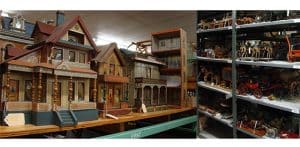 Later, I was introduced to Nic Ricketts, the curator responsible for games and paper ephemera, who to me represented the museum’s trusted guide for its behind-the-scenes collection of antique toys. I may have even gasped as he opened the door to a massive room of open shelving units, containing row upon row of strange and wonderful automata, Noah’s arks, and pull toys—all lovingly made for the pleasure of children. My eyes grew wider as we explored lines of Victorian dollhouses with intricate chromolithographs glued to every surface.
Later, I was introduced to Nic Ricketts, the curator responsible for games and paper ephemera, who to me represented the museum’s trusted guide for its behind-the-scenes collection of antique toys. I may have even gasped as he opened the door to a massive room of open shelving units, containing row upon row of strange and wonderful automata, Noah’s arks, and pull toys—all lovingly made for the pleasure of children. My eyes grew wider as we explored lines of Victorian dollhouses with intricate chromolithographs glued to every surface.
But for me, the best was yet to come as we reached the climate-controlled room housing steel flat files. Nic spent hours opening drawers filled with board games, stacking blocks, and picture puzzles made during the middle to late 1800s. I could hardly contain myself.
Cardboard soldiers begged to be picked up and played with. Alphabet blocks rested there as well, all covered in the rich chromolithographs so characteristic of this period—images that would surely inspire my work.
On the third day, I was able to find my way back to the security entrance unaided, quite an accomplishment I thought, given the maze-like quality of the museum. The last day I discovered a gallery in the main part of the museum that I had previously missed—how was that even possible? Obviously, there was still more to see, but by this time, my mind was whirling around like one of the wooden horses on the ground floor carousel next to the full-sized stainless steel diner that serves half-price milkshakes every afternoon. I staggered toward the exit for the last time exhausted, visually saturated, and ready to get back to my studio to work.
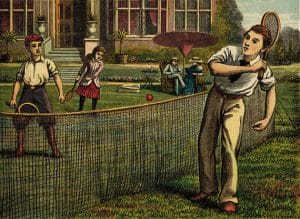 Back in my studio, I sorted through my own archives and selected an 1895 book illustration that was printed using the chromolithographic process. I sectioned it off much like one of the dissected puzzles I had seen in the museum’s drawers and added a story line. Imagining a schoolmarm from the 1800s dreaming of a new way to teach her children to read, I placed my dissected book on a cylinder and added a motor.
Back in my studio, I sorted through my own archives and selected an 1895 book illustration that was printed using the chromolithographic process. I sectioned it off much like one of the dissected puzzles I had seen in the museum’s drawers and added a story line. Imagining a schoolmarm from the 1800s dreaming of a new way to teach her children to read, I placed my dissected book on a cylinder and added a motor.
 The new book begged to be lit, so I designed a Victorian lampshade, screwed in an Edison bulb, and mounted it to the wall. By pulling a chain, the book rotates in space, the story unfolds, and the viewer pieces the image back together. What is it? The New English Rotary Reader Plucked from a Schoolmarm’s Dream on view at the Cooperstown Art Association National Juried Art Exhibition, starting July 15 through August 19, 2016.
The new book begged to be lit, so I designed a Victorian lampshade, screwed in an Edison bulb, and mounted it to the wall. By pulling a chain, the book rotates in space, the story unfolds, and the viewer pieces the image back together. What is it? The New English Rotary Reader Plucked from a Schoolmarm’s Dream on view at the Cooperstown Art Association National Juried Art Exhibition, starting July 15 through August 19, 2016.




